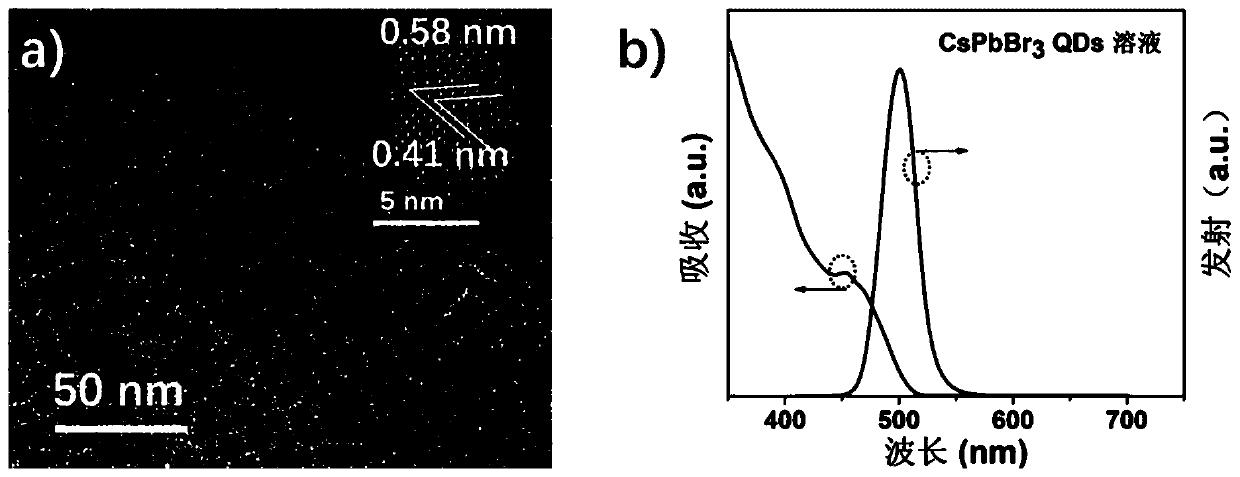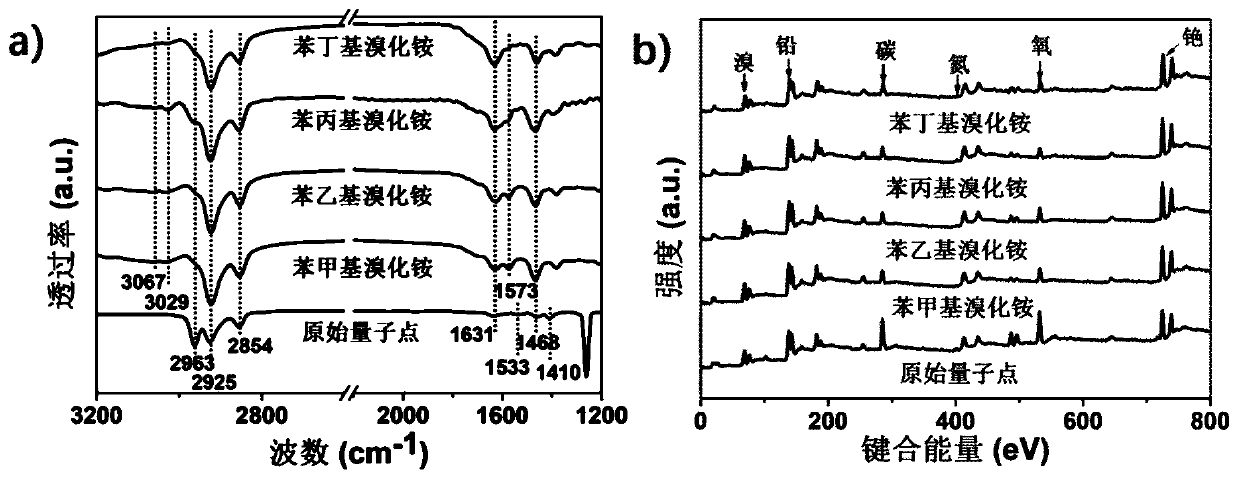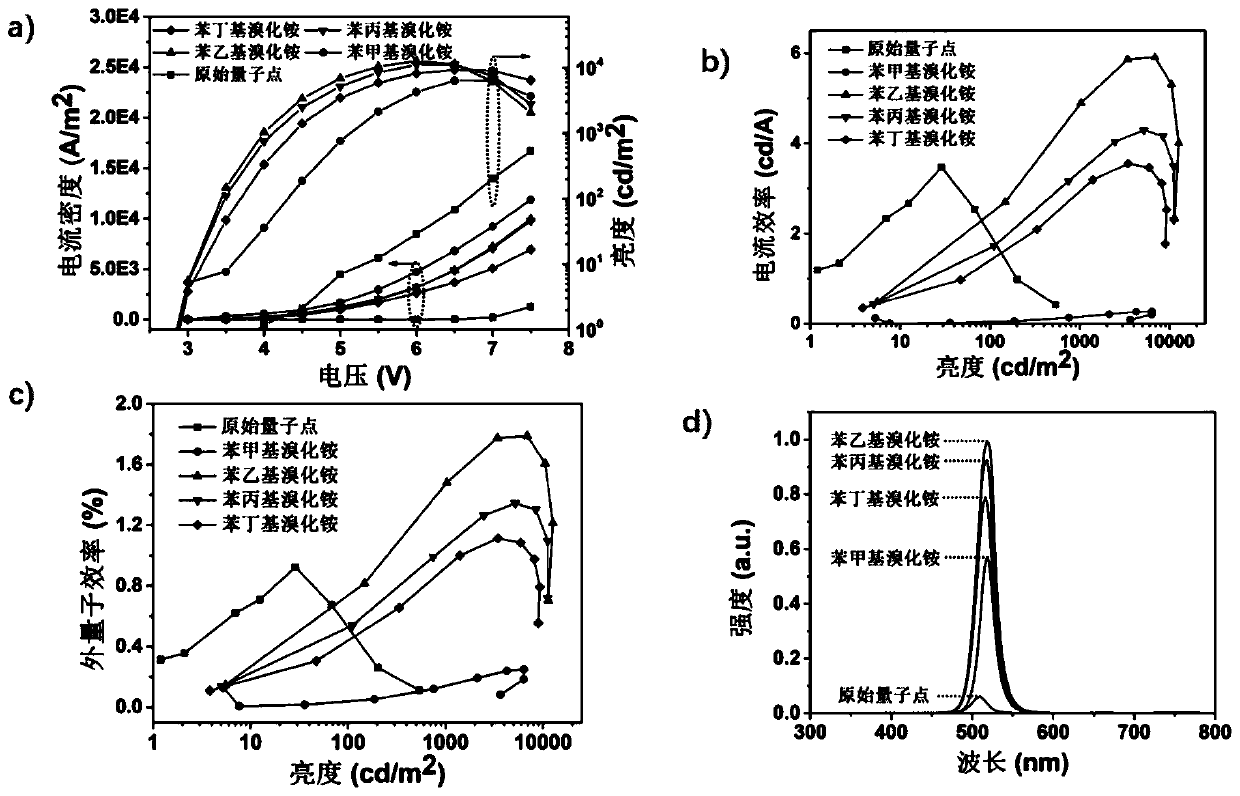A method for preparing cesium-lead-bromine quantum dot electroluminescent device by conjugated molecular ligand solid-liquid exchange method
A technology for preparing cesium lead bromine quantum and electroluminescent devices, which is applied in semiconductor/solid-state device manufacturing, semiconductor devices, electro-solid devices, etc., can solve the problems of limiting carrier transport, catching up with the gap of light-emitting diodes, etc., to improve luminescence Effects of efficiency, low roughness, high luminescence quantum yield
- Summary
- Abstract
- Description
- Claims
- Application Information
AI Technical Summary
Problems solved by technology
Method used
Image
Examples
Embodiment 1
[0035] Embodiment 1: Synthesis and purification of cesium lead bromine quantum dots
[0036] 1a. Preparation of Cesium Oleate Precursor
[0037] First, add 0.5g of cesium carbonate, 2mL of oleic acid and 50mL of octadecene into a 100mL round-bottomed three-necked flask, vacuumize and heat to 120°C for 30 minutes, then stop vacuuming and blow nitrogen for 10 minutes, then start again Vacuumize and cycle three times to remove the moisture and oxygen in the flask, and finally obtain a colorless and clear solution, which is the cesium oleate precursor, which is stirred at 70°C and protected by nitrogen gas, and set aside;
[0038] 1b. Synthesis of cesium lead bromine quantum dots
[0039] Add 0.8g of lead bromide and 50mL of octadecene into a 500ml round-bottomed three-necked flask, stir and heat to 120°C, then vacuumize for one hour, then add 5mL of oleic acid and 5ml of oleylamine, and vacuumize for reaction 15-30 minutes until the lead bromide is completely dissolved, then st...
Embodiment 2
[0042] Embodiment 2: the preparation of phenylalkyl ammonium bromide ligand solution
[0043] Add 1g of phenalkylamine and 15mL of ethanol into a 50mL three-necked flask, stir at 0°C, then dropwise add an equimolar amount of hydrogen bromide aqueous solution (48%), and stop the reaction after stirring for 2 hours at 0°C. Add 45mL ether to the reaction solution, filter to obtain the precipitate, dissolve the precipitate with 5mL ethanol, then add 20mL ether, filter to obtain the precipitate, repeat the dissolution and precipitation process 2-3 times to obtain the phenylalkylammonium bromide ligand; Mmol phenylalkylammonium bromide ligand and 400 μL oleic acid were dissolved in 32 mL methyl acetate, and ultrasonically dispersed to obtain a colorless and clear ligand solution;
[0044] The phenalkylamine is benzalkonium, phenethylamine, amphetamine or phentermine.
[0045] The phenylalkylammonium bromide is benzylammonium bromide, phenethylammonium bromide, phenylpropylammonium ...
Embodiment 3
[0047] First, treat the ITO sheet with ozone for 15 minutes, then spin-coat a layer of poly-3,4-ethylenedioxythiophene on the surface of the ITO sheet (4000 spin-coating for 40 seconds), and anneal at 140 ° C for 10 minutes; Spin-coat a solution of poly[bis(4-phenyl)(4-butylphenyl)amine]chlorobenzene at a concentration of 8 mg / mL in the box (4000 spin-coating for 60 seconds), and anneal at 120°C for 20 minutes; Then spin-coat the 20mg / mL cesium-lead-bromine quantum dot solution prepared in Example 1 (2500 spin-coating for 60 seconds), and process it for 5 minutes at 80°C; ×10 -6 40 nm-thick 1,3,5-tris(1-phenyl-1Hbenzimidazol-2-yl)benzene, 1 nm-thick lithium fluoride and 100 nm-thick aluminum electrode were sequentially vapor-deposited under Pa.
PUM
 Login to View More
Login to View More Abstract
Description
Claims
Application Information
 Login to View More
Login to View More - R&D
- Intellectual Property
- Life Sciences
- Materials
- Tech Scout
- Unparalleled Data Quality
- Higher Quality Content
- 60% Fewer Hallucinations
Browse by: Latest US Patents, China's latest patents, Technical Efficacy Thesaurus, Application Domain, Technology Topic, Popular Technical Reports.
© 2025 PatSnap. All rights reserved.Legal|Privacy policy|Modern Slavery Act Transparency Statement|Sitemap|About US| Contact US: help@patsnap.com



